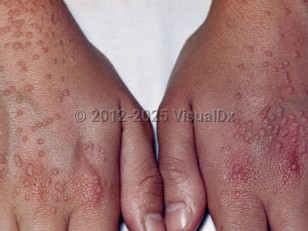Flat wart in Adult
See also in: External and Internal EyeAlerts and Notices
Important News & Links
Synopsis

Flat warts (also known as verruca plana and plane warts) are 1-3 mm, round or oval, slightly raised, smooth papules induced by human papillomavirus (HPV) types 3, 10, 28, and 49. Flat warts are commonly painless and can be yellowish-brown, skin-colored, or pink. They may appear singularly, in clusters, or in a linear arrangement. Flat warts typically present on areas of the body that have contact with other people and objects, such as the face, arms, hands, and feet; however, they can appear anywhere on the body.
The warts arise from benign strains of HPV and are not known to cause cancer. They are contagious and spread easily over the body. Transmission is commonly via person-to-person contact or via fomites. Existing skin trauma (ie, cuts, scratches, burns, eczema) predisposes patients to contracting HPV. A person with flat warts may spread the warts to a different part of the body (autoinoculation) through trauma to the skin such as scratching or shaving.
Children, young adults, and immunocompromised patients are most susceptible. Widespread or extensive warts are often presenting signs of an immunocompromised state. Warts may be more numerous and more difficult to treat in immunocompromised patients. Excessive sun exposure can lead to exacerbation.
While warts are normally self-limited in children, they may be difficult to treat in adults. Longer periods of treatment are usually necessary for adults.
The warts arise from benign strains of HPV and are not known to cause cancer. They are contagious and spread easily over the body. Transmission is commonly via person-to-person contact or via fomites. Existing skin trauma (ie, cuts, scratches, burns, eczema) predisposes patients to contracting HPV. A person with flat warts may spread the warts to a different part of the body (autoinoculation) through trauma to the skin such as scratching or shaving.
Children, young adults, and immunocompromised patients are most susceptible. Widespread or extensive warts are often presenting signs of an immunocompromised state. Warts may be more numerous and more difficult to treat in immunocompromised patients. Excessive sun exposure can lead to exacerbation.
While warts are normally self-limited in children, they may be difficult to treat in adults. Longer periods of treatment are usually necessary for adults.
Codes
ICD10CM:
B07.8 – Other viral warts
SNOMEDCT:
240539000 – Flat wart
B07.8 – Other viral warts
SNOMEDCT:
240539000 – Flat wart
Look For
Subscription Required
Diagnostic Pearls
Subscription Required
Differential Diagnosis & Pitfalls

To perform a comparison, select diagnoses from the classic differential
Subscription Required
Best Tests
Subscription Required
Management Pearls
Subscription Required
Therapy
Subscription Required
References
Subscription Required
Last Reviewed:04/02/2018
Last Updated:04/19/2018
Last Updated:04/19/2018
 Patient Information for Flat wart in Adult
Patient Information for Flat wart in Adult
Premium Feature
VisualDx Patient Handouts
Available in the Elite package
- Improve treatment compliance
- Reduce after-hours questions
- Increase patient engagement and satisfaction
- Written in clear, easy-to-understand language. No confusing jargon.
- Available in English and Spanish
- Print out or email directly to your patient
Upgrade Today

Flat wart in Adult
See also in: External and Internal Eye
